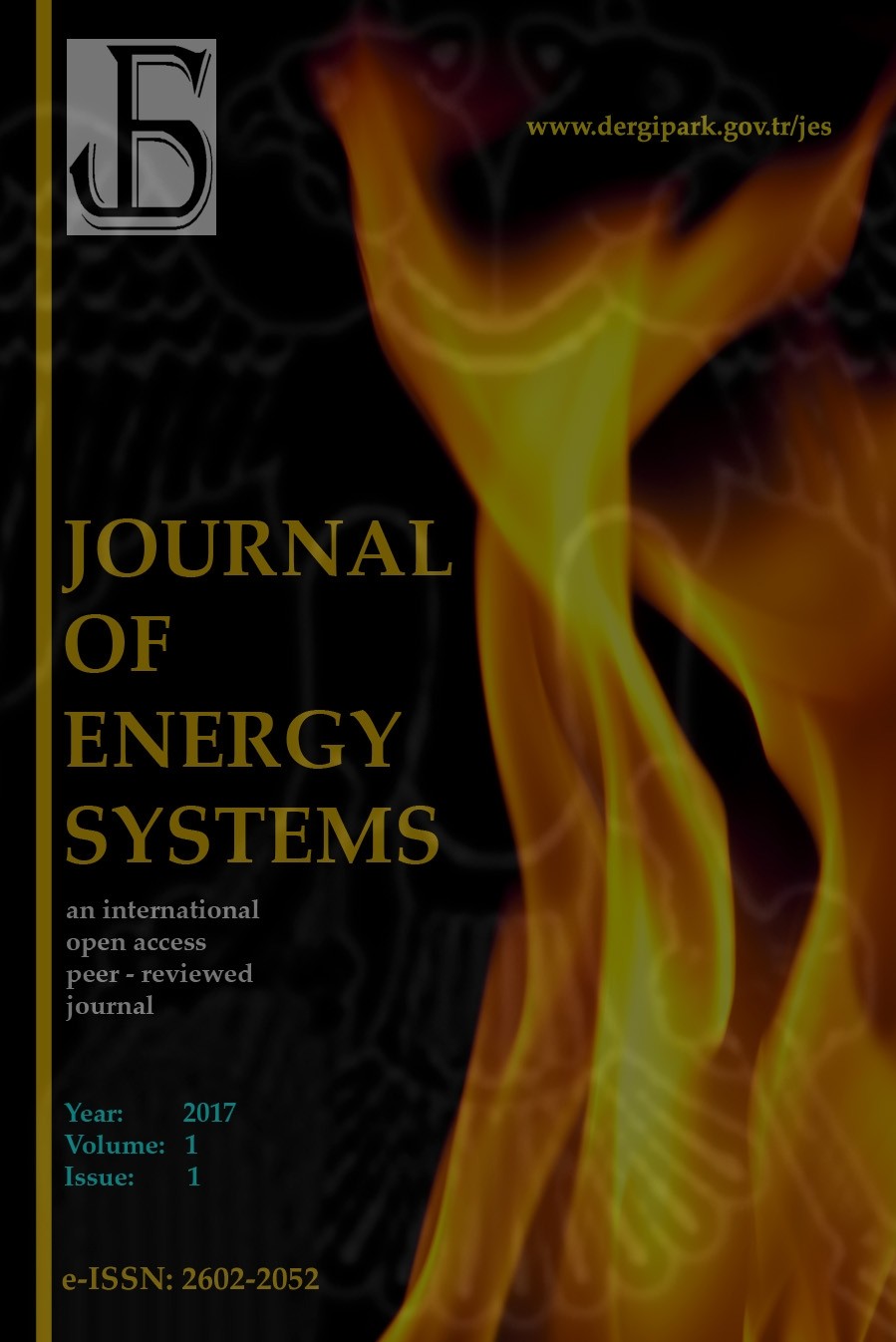Combined cycle gas turbine for combined heat and power production with energy storage by steam methane reforming
Combined cycle gas turbine for combined heat and power production with energy storage by steam methane reforming
Combined cycle gas turbine, Combined heat and power, Maneuverability, Steam methane reforming,
___
- [1] Zaryankin, A, Mager, A, Rogalev, A, Komarov, I. Superpowerful combined cycle power units with one gas turbine. WIT Transactions on Ecology and the Environment 2014; 190(1): 251-260. DOI: 10.2495/EQ140251.
- [2] Rogalev, N, Prokhorov, V, Rogalev, A, Komarov, I, Kindra, V. Steam boilers′ advanced constructive solutions for the ultra-supercritical power plants. International Journal of Applied Engineering Research 2016; 11(18): 9297-9306.
- [3] Lisin, E, Rogalev, A, Strielkowski, W, Komarov, I. Sustainable modernization of the Russian power utilities industry. Sustainability 2015; 7(9): 11378-11400. DOI: 10.3390/su70911378.
- [4] Internet Web-Site: Hub indices: Trading System Administrator of Wholesale Electricity Market Transactions, https://www.atsenergo.ru/results/rsv/hubs/hubs?zone=1.
- [5] Komarnicki, P. Energy storage systems: Power grid and energy market use cases. Archives of Electrical Engineering 2016; 65(3): 495-511. DOI: 10.1515/aee-2016-0036.
- [6] Guney, MS, Tepe, Y. Classification and assessment of energy storage systems. Renewable and Sustainable Energy Reviews 2017; 75: 1187-1197. DOI: 10.1016/j.rser.2016.11.102.
- [7] Alami AH. Mechanical energy storage for renewable and sustainable energy resources. Heidelberg, GERMANY: Springer International Publishing, 2020.
- [8] Sinyugin V, Magruk V, Rodionov V. Hydro-storage power plants in modern electric power industry. Moscow, RUSSIA: Litres, 2018.
- [9] Myasina MA, Kosmynina NM. Study of the modes of the Zagorskaya PHES. In: 23-rd International Symposium of Students and Young Scientists Problems of Geology and Subsurface Development; 8-12 April 2019: TPU Publishing House, Tomsk, Russia, pp. 240-241.
- [10] Frate, GF, Ferrari, L, Desideri, U. Energy storage for grid-scale applications: Technology review and economic feasibility analysis. Renewable Energy 2021; 163: 1754-1772. DOI: 10.1016/j.renene.2020.10.070.
- [11] Ceran, B. A comparative analysis of energy storage technologies. Polityka Energetyczna – Energy Policy Journal 2018; 21(3): 97-110. DOI: 10.24425/124498.
- [12] Alva, G, Lin, Y, Fang, G. An overview of thermal energy storage systems. Energy 2018; 144: 341-378. DOI: 10.1016/j.energy.2017.12.037.
- [13] Rogalev, A, Komarov, I, Kindra, V, Zlyvko, O. Entrepreneurial assessment of sustainable development technologies for power energy sector. Entrepreneurship and Sustainability Issues 2018; 6(1): 429-445. DOI: 10.9770/jesi.2018.6.1(26).
- [14] Rogalev, A, Grigoriev, E, Kindra, V and Rogalev, N. Thermodynamic optimization and equipment development for a high efficient fossil fuel power plant with zero emissions. Journal of Cleaner Production 2019; 236: 117592. DOI: 10.1016/j.jclepro.2019.07.067.
- [15] Valamin, AY, Kultyshev, AY, Bilan, VN, Goldberg, AA, Sakhnin, YA, Shekhter, MV, Aguilera, HCP, Stepanov, MY, Shibaev, TL, Polyaeva, YN. The cogeneration steam turbine of the T-63/76-8.8 type for a series of PGU-300 combined cycle power plants. Thermal Engineering 2012; 59(12): 883-892. DOI: 10.1134/S0040601512120099.
- [16] Karpunin, AP. Study of the influence of the parameters of GTU and CCGT on their characteristics based on the technique with detailed taking into account of losses from cooling in a gas turbine. PhD, National Research University, Moscow, Russia, 2016.
- [17] Trukhnii, AD. Combined-cycle plants of power plants. Moscow, RUSSIA: MPEI, 2013.
- [18] Romano, MC, Cassotti, EN, Chiesa, P, Meyer, J, Mastin, J. Application of the sorption enhanced-steam reforming process in combined cycle-based power plants. Energy Procedia 2011; 4: 1125-1132. DOI: 10.1016/j.egypro.2011.01.164.
- [19] Carapellucci, R, Giordano, L. Upgrading existing gas-steam combined cycle power plants through steam injection and methane steam reforming. Energy 2019; 173: 229-243. DOI: 10.1016/j.energy.2019.02.046.
- [20] Lozza, G, Chiesa, P. Natural gas decarbonization to reduce CO2 emission from combined cycles: Part I – Partial oxidation. J. Eng. Gas Turbines Power 2002; 124(1): 82-88.
- [21] Lozza, G, Chiesa, P. Natural gas decarbonization to reduce CO2 emission from combined cycles: Part II— Steam-methane reforming. J. Eng. Gas Turbines Power 2002; 124(1): 89-95.
- [22] Internet Web-Site: Official exchange rates: Bank of Russia, https://cbr.ru/currency_base/dynamics, Feb 2021.
- [23] Canière, H, Willockx, A, Dick, E, De Paepe, M. Raising cycle efficiency by intercooling in air-cooled gas turbines. Applied Thermal Engineering 2006; 26(16): 1780-1787. DOI: 10.1016/j.applthermaleng.2006.02.008.
- [24] Fahim MA, Alsahhaf TA, Elkilani A. Hydrogen Production. In: Fahim MA, Alsahhaf TA, Elkilani A, editors. Fundamentals of Petroleum Refining. Oxford, UK: Elsevier, 2010. pp. 285-302.
- [25] Equipment design and cost estimation for small modular biomass systems, synthesis gas cleanup, and oxygen separation equipment. Task 1: Cost estimates of small modular systems. Final report. San Francisco, USA: National Renewable Energy Laboratory, 2006.
- [26] Internet Web-Site: H2A: Hydrogen analysis production models: National Renewable Energy Laboratory, https://www.nrel.gov/hydrogen/h2a-production-models.html.
- [27] Corradetti, A, Desideri, U. Analysis of gas-steam combined cycles with natural gas reforming and CO2 capture. Journal of Engineering for Gas Turbines and Power 2005; 127(3): 545-552. DOI: 10.1115/1.1850941.
- [28] Alivanova, SV, Kurennaya, VV. Marginal analysis as the effective method of choice of administrative decisions. Scientific Journal of KubSAU 2012; 80(06): 0801206015.
- Başlangıç: 2017
- Yayıncı: Erol KURT
Techno-economic analysis of a transmission line between an island grid and a mainland grid
Barış Çağrı DİNÇ, Murat FAHRİOGLU, Canraş BATUNLU
Ivan KOMAROV, Sergei OSİPOV, Olga ZLYVKO, Andrey VEGERA, Vladimir NAUMOV
Sensorless current prediction in single phase inverter circuits with machine learning algorithms
Hüseyin TÜRE, Selami BALCI, Kadir SABANCI, Muhammet Fatih ASLAN
Solar energy sector under the influence of Covid-19 pandemic: A critical review
